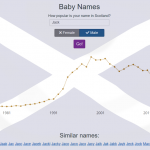Concerns over safety and privacy have been reignited as it came to light that a vast number of adopted Scots children’s names were disclosed on prominent genealogy website, Scotland’s People.
This incident has prompted a deeper examination of the intricate web of genealogy and privacy laws, raising important questions about the balance between historical record preservation and safeguarding sensitive personal information.
The genealogy website in question, operated by the National Records of Scotland (NRS), an official branch of the Scottish Government, found itself under scrutiny when a concerned mother stumbled upon records dating back over a century. The mother, whose identity has been withheld for privacy reasons, voiced her distress about the potential risks posed to her adopted child upon discovering the easily accessible adoption information.
The NRS acted swiftly in response to the mother’s concerns, promptly removing the disclosed information from the website within 36 hours. Acknowledging the gravity of the situation, the NRS launched an internal investigation into the breach and vowed to address the issue with utmost seriousness.
While the incident in question primarily sheds light on the potential consequences of lax data security, it also delves into the ethical complexities of genealogy websites. The delicate balance between unearthing historical records and respecting individual privacy rights is at the core of this matter. Genealogy websites offer invaluable tools for tracing one’s heritage and connecting with long-lost relatives. However, this convenience can come at the cost of exposing deeply personal and potentially sensitive information to unintended audiences.
This incident serves as a poignant reminder of the growing need for robust privacy laws that evolve with the rapid advancement of technology. The Information Commissioner’s Office (ICO) has been informed of the incident as a precautionary measure, highlighting the collaborative effort between governmental bodies to address these challenges. While no personal data breach has been confirmed, the incident underscores the importance of proactive measures to safeguard individuals’ information, especially in the ever-expanding digital landscape.
This incident also draws parallels with a recent real-world case where an individual’s privacy was compromised due to a genealogy website’s data breach. In a similar vein, a story emerged in the press about a person who discovered their adoption details publicly available on a genealogy platform. This breach exposed not only their personal information but also the intricate details of their adoption journey. The victim of this breach, whose identity remains confidential, faced distress and uncertainty as their private history was laid bare for the world to see.
The ripple effects of such breaches can be profound, encompassing emotional distress, identity concerns, and potential security risks. These stories serve as poignant reminders that while genealogy websites can be invaluable tools for connecting individuals to their roots, the potential pitfalls must not be overlooked. Striking the right balance between historical preservation, individual rights, and data security is an ongoing challenge that requires careful consideration and collaboration from various stakeholders.
In the wake of these incidents, the NRS is reevaluating its practices and policies regarding the accessibility of adoption records. The task at hand involves crafting measures that ensure historical records remain accessible for legitimate purposes while guaranteeing that personal information is adequately safeguarded. As discussions and debates surrounding genealogy and privacy continue to evolve, it is clear that a comprehensive and ethical approach is necessary to navigate this intricate terrain.
Image Source:
- Photo by Sabine van Straaten: instant images





